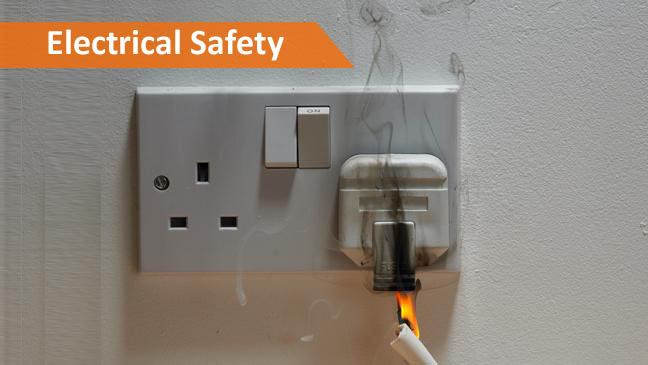Posted on April 14, 2016 in Electrical
Our brief guide to electrical safety for landlords

We have put together this guide to Electrical Safety for Landlords as the government is pretty clear about electrical safety: as a landlord, you’re obliged to ensure all electrical appliances and installations you supply are safe. How you are to interpret these obligations is less clear-cut… This guide to electrical safety for landlords aims to give you some practical advice on making sure your rental property meets electrical safety standards.
Page Contents
By law, you must make sure:
- All electrical installations (e.g. sockets and light fittings) are safe when tenants move in and maintained in a safe condition throughout the duration of the tenancy.
- All electrical appliances you supply, e.g. cookers and kettles, are safe and have (at a minimum) the CE marking.
- A periodic inspection and test is carried out by a registered electrician every five years (only legally required if the property is a House in Multiple Occupation (HMO).
It’s strongly advised that you:
- Commission regular electrical tests on all electrical installations (see ‘Periodic Inspections’ section below).
- Only use registered electricians, even for small jobs. This makes sure you comply with Part P building regulations.
- Ensure your property has sufficient RCD (residual current device) protection.
- Carry out regular visual safety checks.
- Carry out PAT tests (portable appliance tests) on any appliances you supply (more information below).
Take Note
The above measures aren’t legal obligations, but they are best practice as advised by Electrical Safety First. But you don’t want to be known as the landlord who only just meets government safety standards and nothing more. Electrical Safety for Landlords requires you to use best practice.
Periodic inspections
What is a “periodic inspection”?
Inspection and testing to check whether electrical installations are in a satisfactory condition is a major part of electrical safety for landlords .
Who can do it?
The regulations call for “electrically competent persons” to conduct these inspections. But don’t just get your mate to do it – we strongly recommend you use a registered electrician.
How often should it be done?
If the property is an HMO, you must have one every 5 years. If your property isn’t an HMO, it’s still advisable to have one every 5 years, or between tenancies – whichever comes sooner.
Take Note
If the change of tenancy occurs within a short period of time (e.g. no more than 6 months) then you won’t need a full inspection, a visual safety check should suffice.
How much will it cost?
Around £150 is pretty common.
Do I need to keep a record?
Once the inspection has been completed you will be given an Electrical Condition Report (EICR). It’s a good idea to hang on to these.
Portable Appliance Test (PAT)
What is a “Portable Appliance Test”?
Visual inspection of portable electrical appliances, as well as their plugs and leads. Testing of “class 1” equipment will also involve injecting testing signals to ensure integrity.
Who can do it?
“Electrically competent persons” such as registered electricians.
How often should a PAT test be done?
There’s no specific guidance on how often you should carry out PAT testing. The Health and Safety Executive (HSE) advises you take a risk-based approach. Check high-risk items more often – things like kettles and microwaves which are heavily used and often moved around.
How much will it cost?
It depends how many appliances need testing. Some companies charge by the hour, while some charge £1-2 per appliance.
Do I need to keep a record?
Once the inspection has been completed you will be given an Electrical Condition Report (EICR). It’s a good idea to hang on to these.
For more information please Call 0845 604 1288 or visit our Electrical Service section.
Electrical work we do:
|
|
|
Categories
- Building Maintenance
- Cleaning
- Electrical
- Gardening
- General Info
- Our Service
- Pest
- Security
- Uncategorized
- Waste Solutions
Archive
- April 2024
- March 2024
- February 2024
- January 2024
- December 2023
- November 2023
- August 2023
- April 2023
- February 2023
- January 2023
- December 2022
- November 2022
- October 2022
- September 2022
- August 2022
- July 2022
- June 2022
- May 2022
- April 2022
- March 2022
- February 2022
- January 2022
- December 2021
- October 2021
- September 2021
- August 2021
- July 2021
- June 2021
- May 2021
- April 2021
- March 2021
- February 2021
- January 2021
- December 2020
- November 2020
- October 2020
- September 2020
- August 2020
- July 2020
- June 2020
- May 2020
- April 2020
- March 2020
- February 2020
- January 2020
- December 2019
- November 2019
- October 2019
- September 2019
- August 2019
- July 2019
- June 2019
- May 2019
- April 2019
- March 2019
- February 2019
- January 2019
- December 2018
- November 2018
- October 2018
- September 2018
- August 2018
- July 2018
- June 2018
- May 2018
- April 2018
- March 2018
- February 2018
- January 2018
- December 2017
- November 2017
- October 2017
- September 2017
- August 2017
- July 2017
- June 2017
- May 2017
- April 2017
- March 2017
- February 2017
- January 2017
- December 2016
- November 2016
- October 2016
- September 2016
- August 2016
- July 2016
- June 2016
- May 2016
- April 2016
- March 2016
- February 2016
- January 2016
- December 2015
- November 2015
- October 2015
- September 2015
- August 2015
- July 2015
- June 2015
- May 2015
- April 2015
- March 2015
- February 2015
- January 2015
- October 2014
- May 2013
- April 2013
- November 2011
- September 2011
- June 2011
- January 2011
- December 2010
- November 2010


